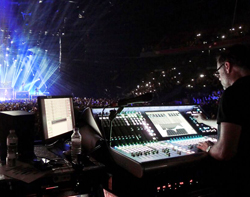
Sam Smith’s debut album, In the Lonely Hour, was one of the biggest of 2014, yielding three number one songs, three top 10 hits and six Grammy Award nominations.
Smith spent the first half of 2015 on a whirlwind worldwide tour. Looking for a console that would best withstand the intensity of the tour while also supporting the singer’s unique sound, Smith’s front of house engineer Simon Thomas selected a Solid State Logic Live. L500 console supplied by Clair Global.
Following his much publicized break for medical reasons Smith is now back out on tour. Smith has headlined a U.S. arena tour, a half-dozen European shows and four multi-night U.K. stands. His summer itinerary is a festival hopscotch between large arenas and smaller music halls in Europe and the U.S., culminating it all at Brazil’s Rock in Rio in September.
An industry veteran who has worked with the likes of B.B. King, Moby and Kylie Minogue, Thomas had his pick of consoles to mix Smith’s world tour. He ultimately chose SSL Live for its unmatched sound quality. “My favourite feature is that it actually sounds really good, like the best quality analogue board you’ve ever used in your life, but with a digital workflow,” he explains. “That’s something that has been lacking from digital boards. Now, because of SSL Live’s flexibility, I can do anything that I want.
“Unlike other consoles, the SSL offers more delineation between instruments. This is especially obvious with drums; most digital consoles feel like they’ve got a crossover with a gentle slope that makes it sound like all the drums are rolling into one another. The SSL, on the other hand, feels like a crossover with a very defined slope, so the difference between a snare drum and a kick drum and a tom is well-defined, even with regards to the low-mid crack of a snare, which is usually unattainable with digital desks. Though it’s common in the analog world, where you would just drive the pre-amp, you can actually get that same classic sound on the SSL. I get a similar response on Sam’s vocals. His incredibly dynamic voice can be a challenge on digital boards and it’s still the early phases of running it through the SSL preamps, but so far I’ve been really impressed.”
Thomas also finds that the sound of the SSL Live makes it easier for him to mix. “It’s more responsive; I don’t need to be so extreme,” he explains. “When I push a VCA just a couple of dB, I get a noticeable change that is more defined. I find I don’t need to pan things as hard anymore. I still prefer to pan certain things, like keyboards and effects, but we’ve got a string section that I don’t have to move to get the image to change. I feel like it’s more sensitive. I definitely have more image than I had before.
“It’s an incredibly easy user surface, easier than any other console I’ve ever worked on,” Thomas continues. “At first, it was a bit weird because I felt like I wanted more faders, but I’m getting used to the fact that I don’t need them. The faders below the main screen, I keep as VCAs, with additional layers dedicated to outputs and matrix.”
Thomas uses Fader Tile 2 on the lower left for stage inputs and keeps effects and playback on Tile 3. “I’ll have one layer for drums, the next layer will be back line stuff, and another layer will be vocals,” he explains.
Thomas and his team carry full production for the majority of the tour, but are planning to pick up the board in some of the regional territories. “Basically, wherever we go, SSL goes out of its way to make sure we’ve got a desk. With this level of support, I see SSL completely taking over the market.”
